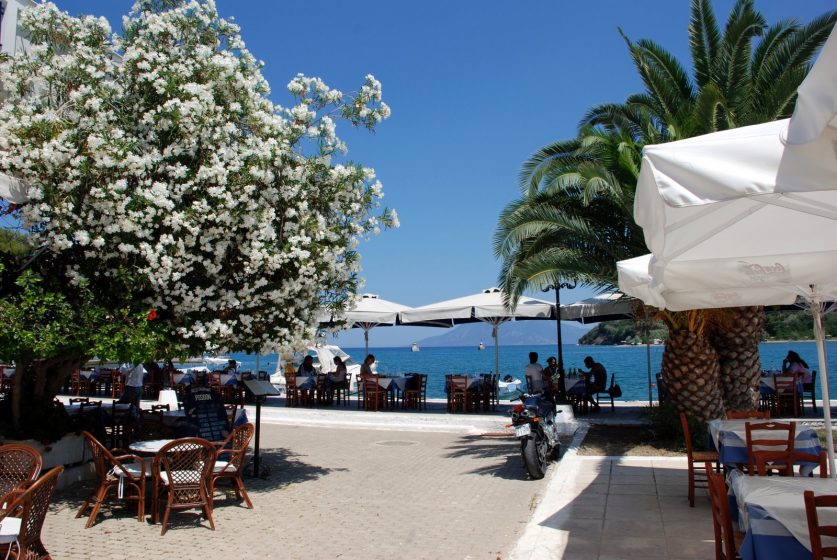In Mycenaean times, Epidavros was a large place with a population of 80,000. Today it is a small fishing village on the Saronic Gulf and east coast of the Peloponnese with about 2,000 inhabitants, who live mainly from agriculture and fishing and in the summer from tourism.
There are several small beaches, taverns, restaurants, bars, a post office, ATMs, stores, campsites and many hotels and apartments. It is “us knows us” here in the village. That makes it friendly and makes you feel welcome.
Approaching Epidavros by car from Corinth, one sees that the village is surrounded by orange and olive trees. In spring, the whole area smells of orange blossoms. The village has a pleasant fishing port where one can buy fish directly from the fisherman in the morning. Around the harbor are many restaurants and tavernas where one can enjoy the wide variety of Greek cuisine. At the port, the diving school “Scuba Blue” is located. A professional diving school both for beginners and advanced divers. In summer, there is a market every Friday and Saturday evening during the month of July where one can taste and buy local agricultural products.
The Nisi Peninsula
To the right of the harbor, you will see a peninsula. This peninsula was formerly home to the “acropolis” or “upper city. On the hill is a small church and one can still find remnants of walls. Also located here is the small theater that sits like a shell against the hill below. Built in the 4th century BC, the theater has 18 rows of seats. Excavation began in 1972, but people are still digging up new pieces. A statue of the god Hermes was unearthed here in September 2011. Since 1995, the theater has been back in operation. During the month of July, there will be a music or theater performance every Friday and Saturday night.
On the other side of the peninsula, one can find under the surface of the water the “sunken city,” remains of Epidavros that disappeared underwater after a volcanic eruption of the volcano on Methana. These remains can still be clearly seen.
The beaches of Epidavros
Epidavros has five different beaches and all five are worth a visit.
The first beach is to the left of the church of Epidavros and is called Vagonia beach. There is very little shade on this beach. There is a changing room, though.
Climbing on foot over the rocks to the left of the beach, one arrives at Kalamaki beach. The beach is very quiet and the water there is also very beautiful. However, there are no facilities.
The third beach is the beach on the Nisi. This is a peninsula located at the transition between the two bays. It is very suitable for swimming with children, as the beach slopes gradually into the sea.
Then there is the beach where you can snorkel to see the remains of the sunken city. One can walk the walls and see the remains of the jars used to store oil and wine. There are free sunbeds. You can also eat delicious fish here for a reasonable price.
The fifth beach is the beach at Galasi. This beach is near the campsites and is very crowded in summer. Here too are free sunbeds and you can have a drink.
The theater of Epidavros
From the present-day village of Archaia Epidavros, it is only a 10-minute drive to the famous theater of Epidavros. It is the best preserved theater in Greece and the acoustics are so good that the performances, given in the summer, take place without amplification. If one whispers softly from the “orchestra,” the circular playing surface where the performance took place, every word is intelligible on the upper rows. Always there are those who try this out and sometimes one can hear a true talent show.
The theater seats 14,000 spectators and was built in the 4th century BCE. Chr., while the upper rows in the 2nd century b. Chr. have been added. In the center of the orchestra is another marble slab where the altar to Dionysos stood. Theater in ancient times developed around the Dionysos cult, in which song, dance and drama played a major role.
The sanctuary of Asklepios
Although today most visitors come primarily to visit the theater, people used to come to visit the shrine of Asklipios, the god of medicine. The practical medicine that took place here was a mixture of traditional knowledge, magic and psychological therapy, but according to methods that could be transmitted. Snakes played an important role in this. The esculape, the snake winding around a staff, is still the symbol of contemporary medicine today.
The shrine consisted of a temple with the so-called “Abaton” behind it, where patients spent the night to find healing. Next to the temple is a “tholos,” or “thymele,” a circular structure with several circles of columns, but archaeologists have yet to agree on its function. The architect was Polykleitos the Younger, who was also the architect of the theater.
The archaeological dig consists of several more buildings, including the propylon, a gymnasium, a stadium and the 2-story hotel with 160 rooms for pilgrims.
